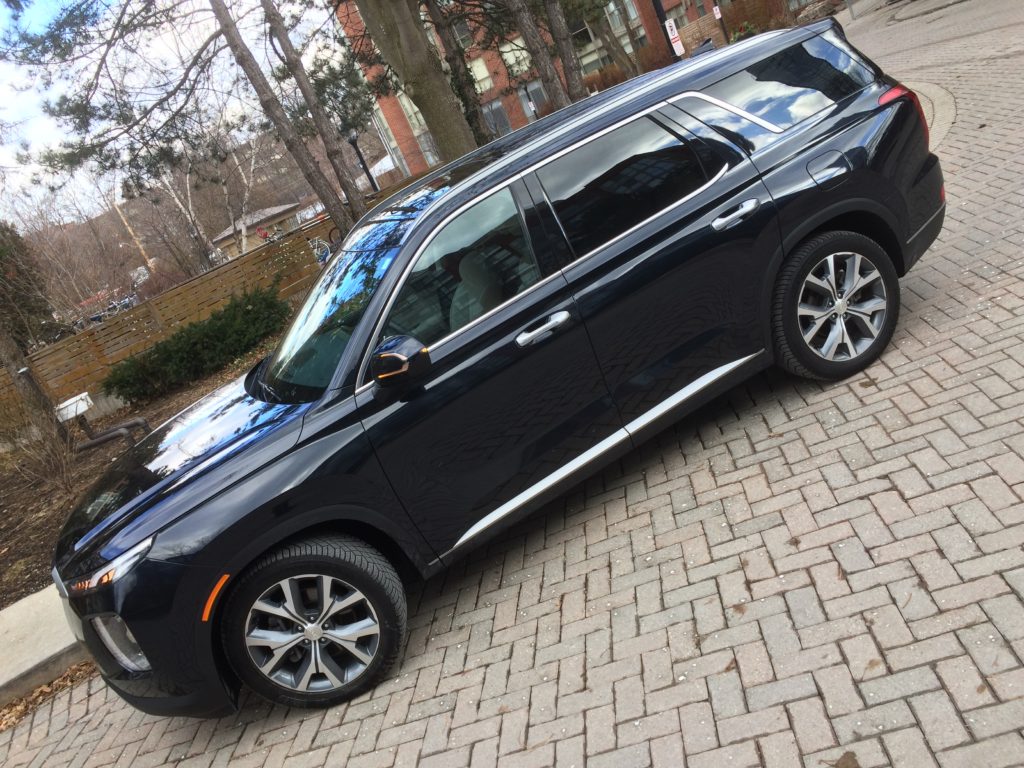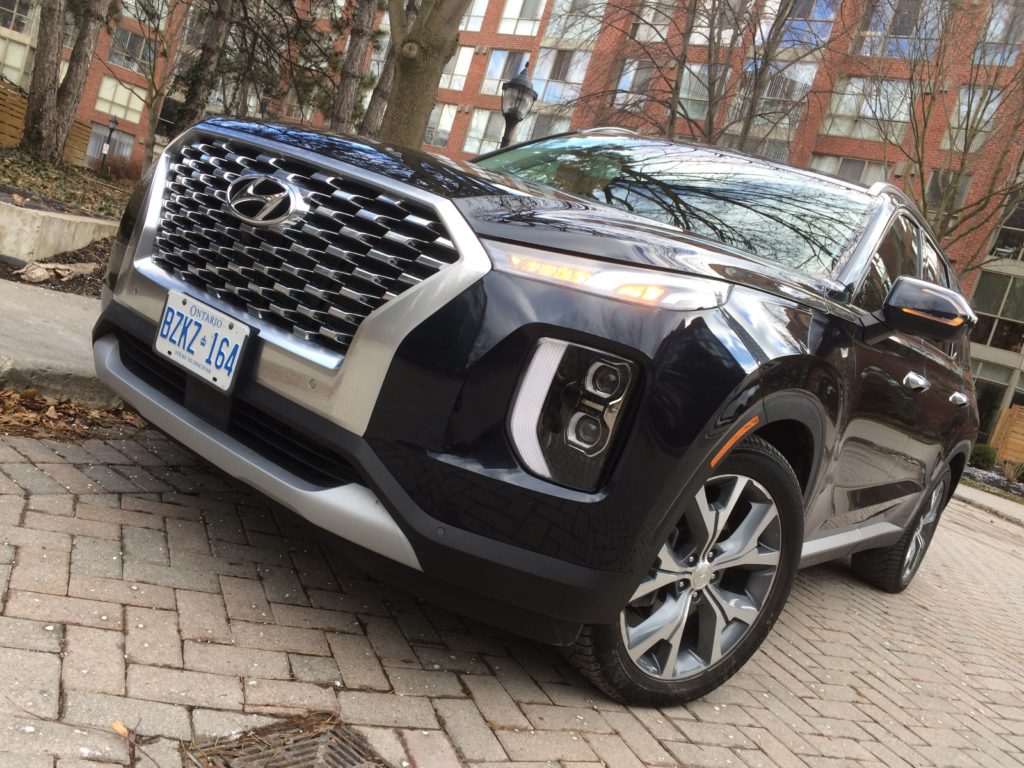We Canadians love our SUVs, so automakers continue to fill every concievable niche in this market. The three-row SUV segment is growing jsut as quickly (at least in terms of choice, if not overall sales) as that of more compact models.
Newcomers to this segment have their work cut out for them. Fortunately, Korean automakers seem up to the task. As of last summer, the all-new 2020 Hyundai Palisade joined the fray, and it’s an impressive effort. Tech-enthusiast parents ought to be particularly impressed.

First impressions
The black Preferred model I drove presents a wide yet seemingly low-slung look, thanks in no small part to the large hood. Modern headlight and taillight systems accent a somewhat boxy look suggestive of vehicles you’d expect to find driving around English country estates. The body won’t be mistaken for the outgoing Santa Fe XL.

A “cascading” wide grill dominates the front end of the vehicle, and the look flows smoothly over the hood and along the sides.

The overall length is accented by tinted rear windows on the Preferred model I drove. The length is markedly obvious (as is the width) when you pull into a mall parking spot. The Palisade unabashedly fills it up.
Interior
All that volume apparent on the outside gave Hyundai designers plenty of room to work with on the inside. The Palisade interior is both modern and attractive. Wood trim alternates with leather and other high-end materials everywhere you look, or touch. Heated and cooled front seats and heated second-row seats (all leather, as are the third-row seats) offer plenty of head and leg room.

The centre stack may be the best-designed spot in the vehicle. When the snap-out cupholders are rolled back, the space they leave combines with the remainder of this storage spot to create a larger cubby. It supplements a large storage space under the centre armrest. When the forward portion is closed, the silver cover material matches the rest of the centre stack background. The remainder of the centre stack, from the four transmission buttons to the seat heating and cooling buttons to the climate controls to the eight buttons for the centre infotainment stack, are laid out in a way that brings the interiors of high-end marques to mind.

The same attention to detail can be found throughout the vehicle, including the third row of seats. Rear-vent diffusers bring airflow to second- and third-row passengers, controlled partly by climate controls accessible in the second row. Seven USB outlets partner with 16 cupholders, plus other spots where occupants can charge and store their devices.
Any parents reading this must be nodding their heads, but there’s more. To the right of the centre touchscreen, Hyundai designers placed indicators that quickly tell the driver if any of the seatbelts are not in use. The Driver-Talk intercom system enables the driver to speak with either second- or third-row occupants. Music can be funnelled to specific rows in this SUV as well. All these touches add up to more parental peace of mind than is on offer in just about any other vehicle on the market.

I have but one quibble—reaching for the radio tuning knob to the far right of the infotainment control buttons meant I needed to lean out of my seat. Once favourite stations were programmed, though, I rarely found myself reaching for that knob, preferring the controls mounted on the steering wheel.
Hockey bag test
The bag just keeps the automatic hatch door from closing, so I needed to lower one of the third-row seats. The wall of the left side of the hatch offers buttons that lower and raise these seats, and lower the second-row seats as well. Sticks easily slid in beside the bag.

In-cabin technology
The instrument cluster and centre 12.3-inch touchscreen share the same top bezel, forming an attractive (if subtle) line across the top of the dash.
The wide centre screen easily accommodates three separate sections, and Hyundai’s control system is straightforward enough. It also accommodates Apple CarPlay ™ and Android Auto ™ for people who prefer those interfaces.
A screen in the middle of the instrument cluster is flanked by the standard two gauges. While the screen shows plenty of features, it also shows the right flank of the car looking backwards when the driver uses the right turn signal. The same feature exists on the left. This Blind View Monitor may be the most intelligent use ever imagined for this screen. Pictures of what’s in a blind spot augment the Palisade’s blind-spot warning system, keeping drivers extra aware of their surroundings.
A wireless charging pad in front accommodates a wide range of smartphones.
Driving
An Atkinson-cycle 3.8-liter V6, dual CVVT, direct-injected engine supplies 291 hp and 262 lb-ft of torque. Passing power is sufficient, though any attempt at “quick” driving quickly reminds you of this vehicle’s size. I say this regardless of the vehicle’s “sport” driving mode which sends more torque to the rear wheels in this HTRAC All-Wheel Drive active on-demand powertrain. However, as a daily driver, it’s a civilized ride. Drive it as an adult would, and it will serve you well.
Power travels through an 8-speed transmission. Yes, the de rigeuer paddle shifters adorn the steering wheel. No, I don’t understand why they’d be there on a vehicle this size. I’ve written this before and I’ll do so again: paddle shifters serve little purpose on an SUV. The same goes for sport mode (previously noted), though other driving modes (eco and smart) make plenty of sense here.
In the “why didn’t I think of that?” department, the shift-by-wire system’s automatic park logic shifts the vehicle into Park when the Palisade’s engine is off and the driver opens the door. If you’ve ever tried to start a car when it’s in Drive, you’ll appreciate this feature. (If you haven’t, the car will appear to have a dead battery, you may be puzzled, then embarrassed when roadside assistance shows up to get you going.)
Abundant active safety technologies come packaged as Hyundai Smartsense. Adaptive cruise control partners with lane guidance to help drivers maintain a decent following distance while also staying in a chosen lane. Forward collision avoidance, a driver attention warning and rear cross-traffic collision avoidance assistance round out the comprehensive safety “cushion” that Hyundai delivers in the Palisade. Oh, and when parking, remember to turn on the cameras—the 360-degree view helps you perfectly place the Palisade.
Fuel economy
Hyundai publishes city/highway/combined numbers of 12.3 L/100 km, 9.6 L/100 km and 11.1 L/100 km, respectively for AWD. Consumption is a little better in FWD. Engine start-stop technology helps keep these numbers reasonable when the Palisade rests at a stop sign, traffic light, or has to idle for any reason.
Pricing
The 2020 Hyundai Palisade retails for $38,499 (FWD model) MSRP. The Preferred model tested sells for $45,499.